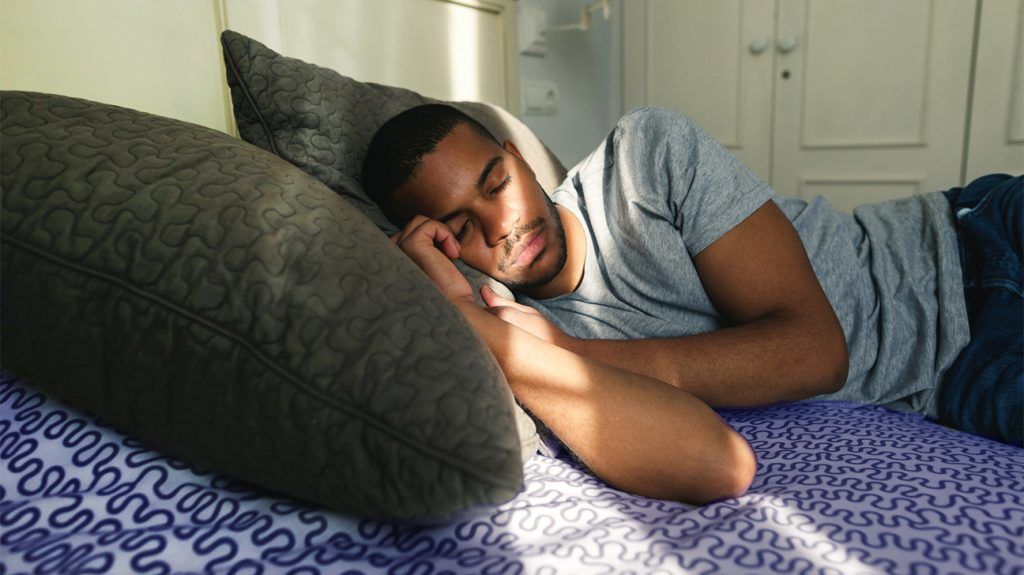Have you ever wondered what happens when you sleep? Interestingly, a lot goes on with your brain and body while you’re catching some Zzz’s.

While you’re snoozing, your mind and body journey through a series of events designed to reduce your consciousness and awareness, relax your muscles and alter your brain waves. Some organs get to power down to minimal functionality to maintain or reset, while others get to work as a cleanup crew after the main event.
These events play out in stages that repeat in cycles several times throughout a typical 7- to 8-hour sleep session. Yet you remain blissfully unaware of what your brain and body are doing throughout all this activity.
So, how many stages of sleep do you go through? And what is a sleep cycle?
A sleep cycle was once thought to have five distinct stages until the American Academy of Sleep Medicine (AASM) reclassified this in 2007. Now, it’s widely accepted there are four stages you go through per sleep cycle.
A cycle of sleep occurs each time your body completes all four sleep stages. Each stage is characterized by how your brain and body behave during that period. The length of time it takes to complete one whole cycle is roughly around
On average, you may go through four to six sleep cycles during the night, or day if you work the night shift.
Within a sleep cycle are three phases of non-REM (NREM) and one rapid eye movement (REM) sleep phase. REM is the deepest level of sleep and happens toward the end of a sleep cycle. It is also when you are most likely to dream.
So, what are the stages of sleep that happen during a sleep cycle?
In essence
There are 4 sleep stages in 1 sleep cycle.
One cycle lasts about 90 minutes.
Once your head hits the pillow you should have a total of 4–6 sleep cycles before you awake for the day.
Stage 1 (N1)
This non-REM sleep phase occurs in the first several minutes after nodding off and is when your mind is still somewhat alert. During this time, your brain shifts into producing alpha and theta waves, and your heart rate and breathing slow down. This stage can last from 1 to 7 minutes.
Stage 2 (N2)
During this stage, electrical activity in the brain increases in bursts. If you had an electroencephalogram (EEG) test at this time, it would show this activity in the form of spikes called “sleep spindles.” During this roughly 25 minutes non-REM phase, you hover between light and deep sleep.
If napping, the end of this stage would be the ideal time to wake up to avoid the groggy feeling often associated with waking during the following two stages.
Stage 3 (N3)
When you shift into this deeper level of sleep, your brain waves slow down, causing eye movement and muscle activity to cease. Lasting roughly 20 to 40 minutes, this non-REM phase is the point in the sleep cycle where waking is most difficult. It is also when an abrupt awakening will cause grogginess and mental fogginess.
In this stage, the body can carry out tissue repair, boost immune function, and store energy for use the next day.
Stage 4 (REM)
The fourth stage of sleep is the rapid eye movement stage, or REM. The first time you go through the REM stage, it lasts about 10 minutes. As you get toward the end of your sleep cycles, REM can last up to an hour.
EEG recorded brain activity during REM is similar to someone awake. Yet muscles remain inactive due to the action of powerful brain chemicals.
This is also the point in the sleep cycle where some scientists say dreaming occurs. Opinions vary on this, as some research suggests dreaming can occur in REM and non-REM sleep stages.
Reaching the REM stage is essential, as it is how the brain processes daily information for long-term memory storage.
In essence
The 4 sleep stages include 3 non-REM stages and 1 REM stage. Each phase within the roughly 90-minute sleep cycle gets progressively longer.
Stage 1 starts to slow things down, although you’re a bit alert still.
Stage 2 drifts between light and deep sleep, and bookending a sleep session here, around 20 minutes, makes for the ideal nap.
Stage 3 is hard to wake up from, and where deep sleep occurs and your body is more still. It’s also where tissue repair, memory storage, and energy refueling take place.
Stage 4 is that all-necessary rapid eye movement stage where we do the most dreaming and the brain is the most active.
Healthy sleep is as critical for your well-being as eating well and exercising, if not more so.
According to the
In addition to physical health, inadequate sleep can worsen depression and other mental health conditions.
For example, research published in the journal Clinical Psychological Science found sleep-deprived people had more difficulty controlling unpleasant memories and persistent unwanted thoughts. The scientists suggest sleep deprivation may disrupt communication between brain regions responsible for memory and emotions.
If you’re having difficulty getting the restful sleep you need, there are a few things you can do to improve both the length and quality of your next snooze session. But first, it’s helpful to determine how much sleep you really need for maximum health benefits.
How much sleep is enough?
Sleep duration
- Infants (4–11 months): 12–16 hours
- Toddlers (1–2 years): 11–14 hours
- Preschoolers (3–5 years): 10–13 hours
- Children (6–12 years): 9–12 hours
- Teens (13–17 years): 8–10 hours
- Adults (18 and over): a minimum of 7 hours
If you’re looking for ways to improve the length and quality of your sleep cycles, here are a few suggestions that might help:
1. Be consistent in your sleep schedule
Erratic schedules can promote sleep disturbances. Consider having a set bedtime and wake time each day, including days off or on the weekends.
2. Resist the urge to scroll
Although you may enjoy lying in bed and scrolling through social media, research has shown that using electronic devices for at least
3. Avoid large meals, caffeine, and alcohol before bedtime
Caffeine is a known stimulant, but alcohol can also disrupt sleep patterns later in the sleep cycle. Consuming a large meal too close to bedtime can disrupt sleep because it jump-starts the digestion process when your body is trying to rest.
4. Exercise to promote quality sleep
Physical activity during waking hours can help you fall asleep more easily. However, the timing of exercise can matter. If activity tends to boost your energy levels, working out too close to bedtime can hamper your ability to doze off.
It’s probably a best practice to put a 2-hour gap between the end of your workout and bedtime.
5. Change up your sleep location
If you’re having difficulty falling asleep, changing your sleep location by moving to another bed or a comfortable couch might help. For some, a fresh start in another spot is all that’s needed to combat sleeplessness.
6. Get thoughts off your mind and onto paper
Persistent worries can also cause some people to have difficulty falling asleep. If this happens to you, consider keeping a notepad beside your bed to jot down random thoughts that pop up. Writing down your thoughts can ease your mind, especially if you feel like you need to remember them for the next day.
7. Create the ideal sleep environment
Because your sleeping environment can be a factor in sleep duration and quality, consider lowering the temperature in your bedroom, removing any glaring light source, or using a fan or noise machine to block out unwanted sounds.
Sometimes health conditions or medicines can impact sleep quality as well. If you are concerned about the health of your sleep, you might want to talk with a healthcare professional. You can then work together to get your sleep cycles back on track.
You can learn about all the types of sleep disorders here.
Understanding the stages of sleep can help you understand where you’re at in the sleep cycle and pinpoint areas of sleep you can better cultivate for a full and sound rest.
